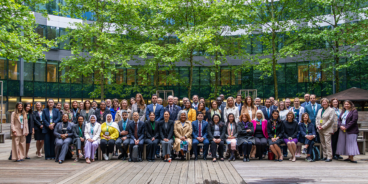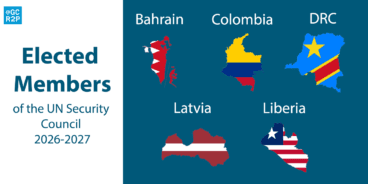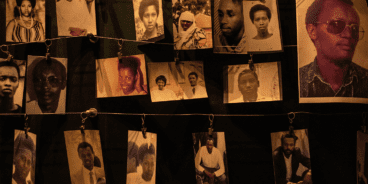
Fulfilling the responsibility to protect: Strengthening our capacities to prevent and halt mass atrocities, 3rd Annual Ministerial Meeting on R2P
On 24 September 2010, a ministerial meeting co-hosted by the Hon. Alhaji Muhammad Mumuni, Minister for Foreign Affairs and Regional Integration of Ghana, and H.E. Ms. Lene Espersen, Foreign Minister of Denmark, and arranged in collaboration with the Global Centre for the Responsibility to Protect, was held on the theme “Fulfilling the responsibility to protect: Strengthening our capacities to prevent and halt mass atrocities”. 21 countries, represented by 9 ministers — including 7 foreign ministers – and senior government officials along with the Secretary-General’s Adviser on the Prevention of Genocide (SAPG) and his Special Adviser on the conceptual, political and institutional development of the Responsibility to Protect (SAR2P) met to discuss how to strengthen capacities to prevent and halt mass atrocity crimes. This was the third annual meeting of its kind held in New York on the margins of the opening of the General Assembly. With 7 participants from Africa, 4 from the Americas, 3 from Asia Pacific and 7 from Europe, the meeting underscored once again that commitment to make a reality of R2P comes from all regions of the world.
In the meeting that one participant described as, “Perhaps the most important event of all such events during the ministerial week,” the discussion moved from concept, theory, and doctrine into the practical field of operationalizing R2P. This emphasis was reflected in the concrete outcomes of the meeting. Many participants announced the designation of national ‘focal points’ for the responsibility to protect — senior officials serving as principal national advisers on R2P with the responsibility to coordinate national efforts and collaborate with other such officials in other governments and institutions to enhance efforts to anticipate, prevent and respond better to “R2P crimes.” There was a commitment to hold a meeting of such focal points within the coming 12 months with a view to this becoming a standing network of specifically designated officials improving inter-governmental coordination on mass atrocity prevention. Participants also sought to meet again at ministerial level, thereby entrenching such a ministerial meeting in New York to discuss fulfilling the responsibility to protect as an annual tradition.
Key Themes of the Discussion
From the outset of the meeting, participants made clear that there was a need to move the debate beyond the definition or purpose of R2P towards operationalizing R2P. One speaker after another referred to the fact that R2P was a response to past failures to act in the face of atrocities, such as those in Cambodia, Rwanda, Liberia or Sierra Leone, where thousands were killed, women suffered horrific sexual violence and child soldiers were recruited. Participants from the Americas and Africa noted that their support for R2P was animated by their national experiences of atrocities perpetrated against the population by past governments or that occurred in their respective regions. There was consensus that the bedrock of R2P is the role of national governments to protect their populations from genocide, war crimes, ethnic cleansing and crimes against humanity; that R2P should be seen as an ally of sovereignty; that the principle is an important corrective to prevent the abuse of sovereignty and the associated norm of non-interference. As one participant noted, “We should all realize that the sovereign right of people to survive is above the sovereignty of a state.” Another noted that the General Assembly’s denouncement of apartheid as a crime against humanity in the 1960s and 1970s was an example of how the GA had recognized the need to react despite the argument of the apartheid regime that this was an internal affair. Several participants spoke of the significance of R2P, with one citing the emergence of the Rome Statute and the 2005 agreement on R2P as, “The two best and most effective recent additions to the arrangements that we have as a community of nations.”
All speakers recognized the urgent need to address the practical challenges governments face in their efforts to prevent mass atrocity crimes. Among these, enhancing early warning of mass atrocities and improving government coordination and collaboration in response were identified as key steps.
Virtually all participants explicitly welcomed the establishment of the joint office of the Secretary-General’s advisers on the prevention of genocide (SAPG) and the responsibility to protect (SAR2P). Several participants explicitly welcomed the SG’s proposed convening mechanism as a necessary development to improve the Secretariat’s role in preventing mass atrocity crimes. Others stressed the better assessment of information as a key missing ingredient in current UN efforts. One highlighted that the governments should be ready to press within the UN General Assembly’s Fifth Committee on Administrative and Budgetary Questions for agreement to provide financial support for the office if it were to become a reality.
Most welcomed a proposal to designate national focal points and to hold a meeting of such focal points within the coming year. Indeed, the bulk of the conversation focused on this ‘logical’ next step of entrenching R2P within institutional structures– whether within the United Nations or at the national or even regional level.
Participants shared thoughts on the function and characteristics of focal points. Many concurred that tackling mass atrocity crimes requires action across many different departments and policy areas, which can present challenges of coordination and focus. As one commented, it is hard to gain space and purchase time and attention within national institutional structures unless there is someone with sufficient stature within the system to make this their continuing responsibility. Many shared this view, emphasizing the importance of the status of the post, stressing that it had to be someone with knowledge and expertise on the R2P and with sufficient seniority to have influence within the institutional system, and ideally, with an independent personality. Most speakers recognized the potential contribution of a national focal point to ensure their government’s capacity for early analysis of an emerging crisis, to help foster institutional consensus on the results of this analysis, and to make possible rapid and focused reaction to the challenges and risks identified.
For several, national focal points would fill the gap in the current institutional architecture that could connect capitals, regional organizations and the United Nations, including the Joint Office for the Special Advisers of the SG for the Prevention of Genocide and R2P. Others noted this would complement ongoing discussions among missions to the UN in New York.
While some participants noted that they already had officials within their institutions coordinating and mobilizing national efforts to prevent mass atrocities, they welcomed in particular the idea of a network of such focal points collaborating.
For all the support for the designation of focal points and the establishment of a network, there were notes of caution – principally that participating in any network should not come at the exclusion of pursuing dialogue and continuing consideration of R2P within the General Assembly. Many stressed the imperative to engage all member states, including those that are most skeptical, on an issue deemed to be of such fundamental import. It was recognized that it was critical to gain the largest possible support for R2P where lives were at stake in order to provide legitimacy to any action taken in its name. One participant noted that, “We need to find forums to convince the skeptical,” with another participant noting that past efforts to persuade skeptics were evidently yielding fruit.
Several participants noted that it was important to pay attention to the concerns of skeptics, not least to their anxieties about selectivity or misuse of the R2P principle. Explicit reference was made to the negative impact of the veto held by the permanent five members of the Security Council. Yet, as one speaker pointedly remarked, the mere possibility of its abuse should not detract from the inherent value of the principles of the responsibility to protect.
In addition to this emphasis on the need for continued outreach – a theme consistent with past ministerial-level meetings — several participants picked up on the theme of education. Education was deemed essential to blunt the edges of intolerance within societies and thus to avoid laying a foundation for mass atrocities to occur. Another emphasized that introducing R2P into the curriculum of secondary education or law schools was essential to introduce populations at large to R2P and to enable future generations to be able to develop the concept and make it as real as the Universal Declaration of Human Rights.
Other preventive tactics included support to efforts to promote alternatives to violence, to engage in peacebuilding, be ready to deter violence, and take action to hold perpetrators of atrocities to account. It was proposed that both the UN Joint Office and the network of focal points could mobilize the most vulnerable states to receive assistance to prevent atrocities.
As with the debates among the UN membership, many participants stressed the pivotal role of regional organizations, pointing variously to the need to pursue the discussion on R2P in such fora; to draw on their knowledge and expertise to warn, prevent and halt atrocities; or to mobilize them to act. The value of having focal points within regional organizations was also noted.
Yet underpinning the entire discussion was a shared intention: to make a difference to those people whose lives are threatened by those determined to commit mass atrocity crimes. Indeed, it was clear to all that the designation of focal points and the establishment of a network of such officials were merely a means to the end of preventing and halting conscience-shocking events. It was recognized that in this, “Our practice lags behind rhetoric.” As one participant plaintively remarked, “Something is going to happen not so long from now and the question will not be about focal points but whether the world is able to muster political will to act more effectively than it has in the past.”
Related Content


2026-2027 UN Security Council Elections and the Responsibility to Protect
